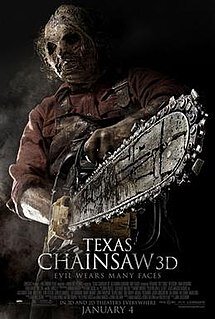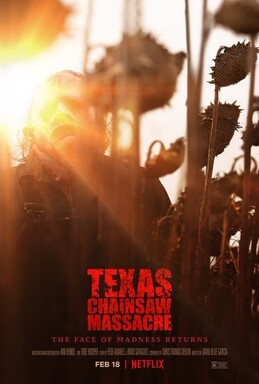Last month saw the release of yet another entry in the Texas Chainsaw Massacre franchise, marking the ninth in the series. This latest sequel (reboot? remake? reboot-quel?) has been largely panned by critics, with RogerEbert.com calling it “a startling misfire” and Rolling Stone concluding “it’s time to put the chainsaw down and walk away.” While many fans agree, some think the critics are being too harsh. One tweet that stood out to me in particular, from user @creepyduckart, said: “Sometimes a film called Texas Chainsaw Massacre is literally about a massacre in Texas with a chainsaw and if you don’t overthink it you might just enjoy it.”
While I agree that the new movie is not entirely deserving of its hate, I want to push back a little on the point made by this tweet. Having seen all of the films in the franchise, I believe there are certain core attributes that define the series. Namely, the films work best when they combine an oppressive atmosphere, a dark sense of humor, and a liberal amount of violence. When deployed right, these ingredients can add up to horror movie magic.
With that in mind, I have decided to analyze the movies in the Texas Chainsaw series and rank them worst to best, based on how effectively they adopt this winning formula. This ranking will be inevitably subjective, but I have tried the best I can to lay aside my personal biases and evaluate the movies on how successful they follow this formula, rather than how much I enjoy them.
Texas Chainsaw Films from Worst to Best
With no further ado, sharpen your saws, and let’s get started with…
Texas Chainsaw 3D (2013)

Like the recent Texas Chainsaw, this 2013 installment attempted to breathe life back into a dying franchise by going back to the beginning. Disregarding every film after the 1974 original, Saw 3D picks up right where that masterpiece left off, even featuring several clips from the first film. This was the filmmakers’ first mistake, as such a direct comparison to a superior film makes Saw 3D look even worse than it is.
Boring, convoluted, and joyless, Texas Chainsaw 3D’s worst sin is that it doesn’t feel like a Texas Chainsaw movie at all. The film is devoid of the sweaty, brutal atmosphere of the original, featuring flat cinematography and bizarre, contemporary soundtrack choices that do nothing to build up tension. The characters, too, have none of the charisma that made the original cast so fun to watch. Leatherface and his family are reimagined as somehow sympathetic (?), undercutting the aura of menace they ought to have. Despite a few effective gore sequences, Texas Chainsaw 3D is a low point in the franchise, evoking none of the humor or dread that made the original so successful.
Texas Chainsaw Massacre (2022)

Like the 2017 reboot before it, the latest film in the Chainsaw canon is guilty of simply not feeling like a Texas Chainsaw movie. This is largely due to the way the film isolates Leatherface away from the rest of his family; this is the first film that does not feature a single other member of the Sawyer/Hewitt Clan. The deranged (and often hilarious) interactions between Leatherface and his family are a core part of what made past movies so great. By depicting Leatherface as a lone killer, he becomes interchangeable with any other slasher villain. One almost wonders if this was originally an unrelated script that was clumsily rewritten to fit into the Chainsaw series.
Like other worst-offenders on this list, TCM ‘22 spends too much time developing a convoluted, nonsensical plot – something about gentrification? – instead of delivering effective scares. There are attempts at humor, a hallmark of the franchise, but they fall embarrassingly flat (the “canceled” joke may be the absolute worst moment in any of these movies.) The one factor keeping this from the bottom is that it does a decent job of building atmosphere; the dusty, abandoned ghost town and fields of dead sunflowers are vaguely reminiscent of the menacing vibes of the original film. Other than that, though, this is yet another installment in the franchise that barely deserves to wear its name.
The Texas Chainsaw Massacre (2003)

As the only true “remake” on this list (every other Chainsaw movie post-2000 acts as some form of belated sequel), TCM ‘03 is the most likely to draw comparisons with the original film. Seen from that perspective, it is hopelessly outmatched. Marcus Nispel’s reimagining of The Texas Chainsaw Massacre,
part of a wave of early 2000s slasher remakes, doesn’t come close to recapturing the nightmarish spirit of the original. Its characters are less engrossing, its script clunkier, and its kills far less memorable – despite being dramatically gorier than the comparatively tame 1974 film.
Still, unlike the films lower on this list, TCM ‘03 does a halfway decent job at actually being a Texas Chainsaw movie. This is most apparent in its grimy atmosphere, thanks in part to the presence of cinematographer Daniel Pearl, who shot the original film. And while they are a far cry from the charisma and hilarity of previous Sawyers, the family members in this film are at least memorable (Sheriff Hoyt, played by R. Lee Ermey, is a particularly despicable character.) Unfortunately, in its attempt to be dark and gritty, the movie avoids the humor that is necessary for a great Texas Chainsaw movie. All in all, it is a valiant attempt, but largely an unsuccessful one.
Leatherface: The Texas Chainsaw Massacre III (1990)

Leatherface is the only one of the original four films to be a true dud. After the comedic left-turn that was TCM2, studio executives reportedly wanted to take the third movie back in the direction of “hardcore horror.” This was their first mistake, as comedy has always been a central part of the Texas Chainsaw franchise. While there are a few moments in this movie that try to be funny – cut to Leatherface learning his ABCs – it is a downright snoozefest compared to the anarchic lunacy of the previous two films.
The bigger problem, though, is that this movie doesn’t really work as “hardcore horror” either. It has none of the punishing atmosphere or nihilistic tone of the first two films, leading to a bland, cookie-cutter final product. Much of this is due to the departure of Tobe Hooper from the franchise. Without Hooper’s unique vision, TCM3 is an unworthy successor to the previous movies. Despite a couple of solid performances – I could watch Ken Foree and Viggo Mortensen in this movie all day – TCM3 marks the beginning of a long downhill for the Texas Chainsaw series.
The Texas Chainsaw Massacre: The Beginning (2006)

Believe it or not, this 2006 prequel is actually a little better than the remake that preceded it. It boasts a tighter script and stronger characters than the ‘03 film,
while also featuring some genuinely terrifying, memorable moments. Highlights include the first time that Leatherface dons his signature skin mask, and a shocking ending that left me genuinely shook. R. Lee Ermey’s Sheriff Hoyt also gets plenty of screen time in this one, delivering what is by far the best performance in any of these films post-2000. There are even a few moments of trademark Texas Chainsaw black comedy: Leatherface performing an unsolicited amputation on his uncle got a good chuckle out of me.
Let’s talk about gore, of which there is plenty to go around in this movie. Throats are slit, skulls are caved in, and bodies are butchered left and right. But The Texas Chainsaw Massacre has never been defined by its gore; the original film is fairly bloodless. Violence works best in the Texas Chainsaw movies when it is sudden, bizarre, and brutal – recall the infamous bludgeoning scene from the first movie. The Beginning relies too much on its graphic violence, sacrificing subtlety for mindless carnage. For this reason, it falls short of being a truly great Texas Chainsaw movie.
Leatherface (2017)

Leatherface (the second movie in the series to hold that title) is far better than it has any right to be. It is also the most narratively ambitious film in the series, abandoning the traditional TCM plot structure and instead telling the origin story of its title character. Equal parts coming-of-age road movie, bleak family drama, and brutal gorefest, Leatherface comes the closest of any post-2000s installment to capturing the true spirit of the Texas Chainsaw franchise.
Some purists might balk at this movie’s high ranking, since it veers so far from the tried-and-true Texas Chainsaw formula. But by experimenting within an established framework, Leatherface expands on the original film’s legacy rather than engaging in rote repetition. And by bookending the main story with two of the best Sawyer family sequences since the 1990s, the film firmly anchors itself in TCM lore. The movie’s opening birthday party scene alone, in all its gleeful gore and over-the-top acting, would be enough to cement this as a worthy and enjoyable Texas Chainsaw movie.
The Texas Chainsaw Massacre: The Next Generation (1995)

Mocked since its release for its bizarre tone and nonsensical plot, The Next Generation might just be the best Chainsaw movie not made by Tobe Hooper. This is no doubt due to the direction of Kim Henkel, who was Hooper’s writing partner on the original film. Consequently, Henkel’s vision of Leatherface and family feels more authentic and visceral than the studio-helmed TCM3. As unconventional as some of his choices may be, Henkel knows the world of Texas Chainsaw on a gut level.
While some fans balk at Henkel’s emphasis on campy, over-the-top humor, I believe it works as a natural evolution of Hooper’s two films. Yes, the film is not particularly gory, and the plot does take some questionable left turns in the final act. But at its heart, the Texas Chainsaw series has always been about unpredictable violence perpetrated by comically deranged characters. That is a letter-perfect description of The Next Generation, in particular Matthew McConnaughey’s performance as the unhinged Vilmer. If you’re going to watch any Texas Chainsaw movie not directed by Tobe Hooper, this should be the one.
Tied for Best: The Texas Chainsaw Massacre (1974) and The Texas Chainsaw Massacre 2 (1985)

The two Texas Chainsaw movies directed by Tobe Hooper operate on another level from anything else in the franchise. While the other movies on this list range from great to unwatchable, TCM & TCM2 are crown jewels of horror filmmaking, chock-full of one unforgettable moment after another. From the brutal, apocalyptic imagery of the original, to the campy splatter of its sequel, these movies comprise a single, sustained peak for the TCM series, and an artistic triumph for one of the greatest horror directors of all time.
The reason I am ranking these movies together is because each one represents different but equally vital components of what defines a Texas Chainsaw movie. The original film is one of the most atmospheric, brutal pieces of horror cinema ever made. It was even marketed as being based on a true story. Watching it, you can feel the sweat pouring down your brow, smell the decay and horror of every moment. The sequel, on the other hand, expands rather than retreads its predecessor, turning its black humor up to eleven. Both films are deeply scary and moody; both shock us with moments of brutal violence; both feature some of the hammiest and memorable performances of their respective decades. In short, both demonstrate everything you need for a perfect and clearly the best Texas Chainsaw Massacre movie.
Sources:
https://www.rollingstone.com/movies/movie-reviews/texas-chainsaw-massacre -review-netflix-1302675/
https://www.rogerebert.com/reviews/texas-chainsaw-massacre-movie-review-2 022

Joseph Green is a writer, filmmaker, and lifelong horror nut. When he isn’t watching horror movies or listening to heavy metal music, he is writing articles about them.
